
- •Preface
- •About This Book
- •Acknowledgments
- •Contents at a Glance
- •Contents
- •Relaxing at the Beach
- •Dressing the Scene
- •Animating Motion
- •Rendering the Final Animation
- •Summary
- •The Interface Elements
- •Using the Menus
- •Using the Toolbars
- •Using the Viewports
- •Using the Command Panel
- •Using the Lower Interface Bar Controls
- •Interacting with the Interface
- •Getting Help
- •Summary
- •Understanding 3D Space
- •Using the Viewport Navigation Controls
- •Configuring the Viewports
- •Working with Viewport Backgrounds
- •Summary
- •Working with Max Scene Files
- •Setting File Preferences
- •Importing and Exporting
- •Referencing External Objects
- •Using the File Utilities
- •Accessing File Information
- •Summary
- •Customizing Modify and Utility Panel Buttons
- •Working with Custom Interfaces
- •Configuring Paths
- •Selecting System Units
- •Setting Preferences
- •Summary
- •Creating Primitive Objects
- •Exploring the Primitive Object Types
- •Summary
- •Selecting Objects
- •Setting Object Properties
- •Hiding and Freezing Objects
- •Using Layers
- •Summary
- •Cloning Objects
- •Understanding Cloning Options
- •Mirroring Objects
- •Cloning over Time
- •Spacing Cloned Objects
- •Creating Arrays of Objects
- •Summary
- •Working with Groups
- •Building Assemblies
- •Building Links between Objects
- •Displaying Links and Hierarchies
- •Working with Linked Objects
- •Summary
- •Using the Schematic View Window
- •Working with Hierarchies
- •Setting Schematic View Preferences
- •Using List Views
- •Summary
- •Working with the Transformation Tools
- •Using Pivot Points
- •Using the Align Commands
- •Using Grids
- •Using Snap Options
- •Summary
- •Exploring the Modifier Stack
- •Exploring Modifier Types
- •Summary
- •Exploring the Modeling Types
- •Working with Subobjects
- •Modeling Helpers
- •Summary
- •Drawing in 2D
- •Editing Splines
- •Using Spline Modifiers
- •Summary
- •Creating Editable Mesh and Poly Objects
- •Editing Mesh Objects
- •Editing Poly Objects
- •Using Mesh Editing Modifiers
- •Summary
- •Introducing Patch Grids
- •Editing Patches
- •Using Modifiers on Patch Objects
- •Summary
- •Creating NURBS Curves and Surfaces
- •Editing NURBS
- •Working with NURBS
- •Summary
- •Morphing Objects
- •Creating Conform Objects
- •Creating a ShapeMerge Object
- •Creating a Terrain Object
- •Using the Mesher Object
- •Working with BlobMesh Objects
- •Creating a Scatter Object
- •Creating Connect Objects
- •Modeling with Boolean Objects
- •Creating a Loft Object
- •Summary
- •Understanding the Various Particle Systems
- •Creating a Particle System
- •Using the Spray and Snow Particle Systems
- •Using the Super Spray Particle System
- •Using the Blizzard Particle System
- •Using the PArray Particle System
- •Using the PCloud Particle System
- •Using Particle System Maps
- •Controlling Particles with Particle Flow
- •Summary
- •Understanding Material Properties
- •Working with the Material Editor
- •Using the Material/Map Browser
- •Using the Material/Map Navigator
- •Summary
- •Using the Standard Material
- •Using Shading Types
- •Accessing Other Parameters
- •Using External Tools
- •Summary
- •Using Compound Materials
- •Using Raytrace Materials
- •Using the Matte/Shadow Material
- •Using the DirectX 9 Shader
- •Applying Multiple Materials
- •Material Modifiers
- •Summary
- •Understanding Maps
- •Understanding Material Map Types
- •Using the Maps Rollout
- •Using the Map Path Utility
- •Using Map Instances
- •Summary
- •Mapping Modifiers
- •Using the Unwrap UVW modifier
- •Summary
- •Working with Cameras
- •Setting Camera Parameters
- •Summary
- •Using the Camera Tracker Utility
- •Summary
- •Using Multi-Pass Cameras
- •Creating Multi-Pass Camera Effects
- •Summary
- •Understanding the Basics of Lighting
- •Getting to Know the Light Types
- •Creating and Positioning Light Objects
- •Viewing a Scene from a Light
- •Altering Light Parameters
- •Working with Photometric Lights
- •Using the Sunlight and Daylight Systems
- •Using Volume Lights
- •Summary
- •Selecting Advanced Lighting
- •Using Local Advanced Lighting Settings
- •Tutorial: Excluding objects from light tracing
- •Summary
- •Understanding Radiosity
- •Using Local and Global Advanced Lighting Settings
- •Working with Advanced Lighting Materials
- •Using Lighting Analysis
- •Summary
- •Using the Time Controls
- •Working with Keys
- •Using the Track Bar
- •Viewing and Editing Key Values
- •Using the Motion Panel
- •Using Ghosting
- •Animating Objects
- •Working with Previews
- •Wiring Parameters
- •Animation Modifiers
- •Summary
- •Understanding Controller Types
- •Assigning Controllers
- •Setting Default Controllers
- •Examining the Various Controllers
- •Summary
- •Working with Expressions in Spinners
- •Understanding the Expression Controller Interface
- •Understanding Expression Elements
- •Using Expression Controllers
- •Summary
- •Learning the Track View Interface
- •Working with Keys
- •Editing Time
- •Editing Curves
- •Filtering Tracks
- •Working with Controllers
- •Synchronizing to a Sound Track
- •Summary
- •Understanding Your Character
- •Building Bodies
- •Summary
- •Building a Bones System
- •Using the Bone Tools
- •Using the Skin Modifier
- •Summary
- •Creating Characters
- •Working with Characters
- •Using Character Animation Techniques
- •Summary
- •Forward versus Inverse Kinematics
- •Creating an Inverse Kinematics System
- •Using the Various Inverse Kinematics Methods
- •Summary
- •Creating and Binding Space Warps
- •Understanding Space Warp Types
- •Combining Particle Systems with Space Warps
- •Summary
- •Understanding Dynamics
- •Using Dynamic Objects
- •Defining Dynamic Material Properties
- •Using Dynamic Space Warps
- •Using the Dynamics Utility
- •Using the Flex Modifier
- •Summary
- •Using reactor
- •Using reactor Collections
- •Creating reactor Objects
- •Calculating and Previewing a Simulation
- •Constraining Objects
- •reactor Troubleshooting
- •Summary
- •Understanding the Max Renderers
- •Previewing with ActiveShade
- •Render Parameters
- •Rendering Preferences
- •Creating VUE Files
- •Using the Rendered Frame Window
- •Using the RAM Player
- •Reviewing the Render Types
- •Using Command-Line Rendering
- •Creating Panoramic Images
- •Getting Printer Help
- •Creating an Environment
- •Summary
- •Creating Atmospheric Effects
- •Using the Fire Effect
- •Using the Fog Effect
- •Summary
- •Using Render Elements
- •Adding Render Effects
- •Creating Lens Effects
- •Using Other Render Effects
- •Summary
- •Using Raytrace Materials
- •Using a Raytrace Map
- •Enabling mental ray
- •Summary
- •Understanding Network Rendering
- •Network Requirements
- •Setting up a Network Rendering System
- •Starting the Network Rendering System
- •Configuring the Network Manager and Servers
- •Logging Errors
- •Using the Monitor
- •Setting up Batch Rendering
- •Summary
- •Compositing with Photoshop
- •Video Editing with Premiere
- •Video Compositing with After Effects
- •Introducing Combustion
- •Using Other Compositing Solutions
- •Summary
- •Completing Post-Production with the Video Post Interface
- •Working with Sequences
- •Adding and Editing Events
- •Working with Ranges
- •Working with Lens Effects Filters
- •Summary
- •What Is MAXScript?
- •MAXScript Tools
- •Setting MAXScript Preferences
- •Types of Scripts
- •Writing Your Own MAXScripts
- •Learning the Visual MAXScript Editor Interface
- •Laying Out a Rollout
- •Summary
- •Working with Plug-Ins
- •Locating Plug-Ins
- •Summary
- •Low-Res Modeling
- •Using Channels
- •Using Vertex Colors
- •Rendering to a Texture
- •Summary
- •Max and Architecture
- •Using AEC Objects
- •Using Architectural materials
- •Summary
- •Tutorial: Creating Icy Geometry with BlobMesh
- •Tutorial: Using Caustic Photons to Create a Disco Ball
- •Summary
- •mental ray Rendering System
- •Particle Flow
- •reactor 2.0
- •Schematic View
- •BlobMesh
- •Spline and Patch Features
- •Import and Export
- •Shell Modifier
- •Vertex Paint and Channel Info
- •Architectural Primitives and Materials
- •Minor Improvements
- •Choosing an Operating System
- •Hardware Requirements
- •Installing 3ds max 6
- •Authorizing the Software
- •Setting the Display Driver
- •Updating Max
- •Moving Max to Another Computer
- •Using Keyboard Shortcuts
- •Using the Hotkey Map
- •Main Interface Shortcuts
- •Dialog Box Shortcuts
- •Miscellaneous Shortcuts
- •System Requirements
- •Using the CDs with Windows
- •What’s on the CDs
- •Troubleshooting
- •Index
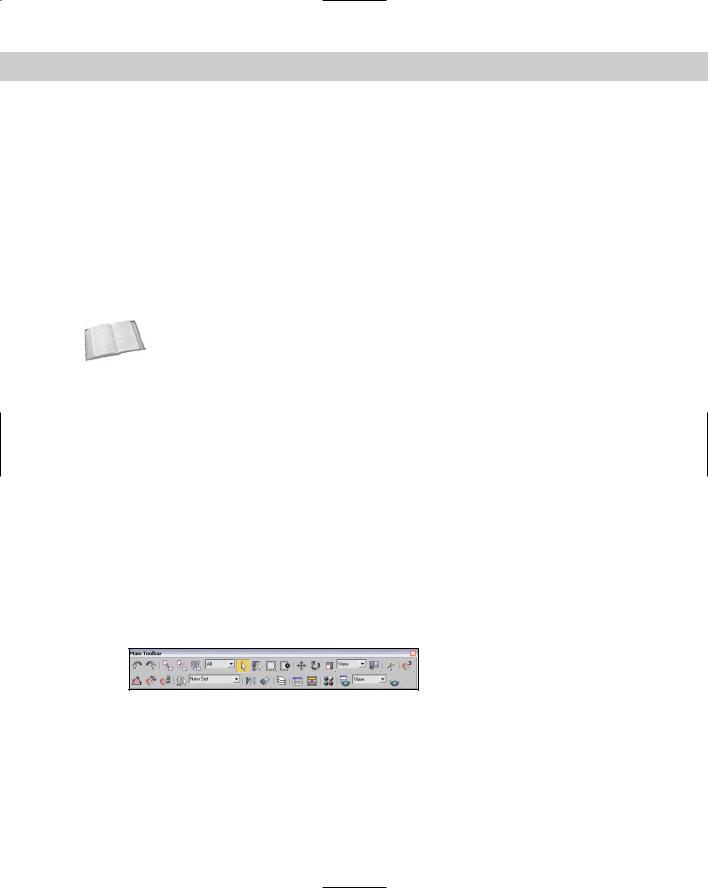
Chapter 1 Finding Your Way — Exploring the Max Interface |
37 |
The Help menu
The Help menu is a valuable resource that provides access to reference materials and tutorials. The New Features Guide, User Reference, and MAXScript Reference are comprehensive help systems that work like a Web browser. The Tutorial command loads the tutorials, which offer a chance to gain valuable experience.
The Hotkey Map displays an interactive interface for learning all the keyboard shortcuts. Additional Help presents help systems for any external plug-ins that are loaded. The 3ds max on the Web options (Online Support, Updates, Resources, and Partners) automatically opens a Web browser and loads the Discreet Support Web pages or looks for updates.
The Authorize 3ds max command lets you enter an authorization number to authorize the software. The About 3ds max command opens the About dialog box. This dialog box displays the serial number and current display driver.
Cross- |
Most of the Help menu commands are covered at the end of this chapter in the section titled |
Reference |
“Getting Help.” |
|
Using the Toolbars
Now that you’ve learned the menu two-step, it is time for the toolbar one-step. The main toolbar appears by default directly under the menus at the top of the Max window; the reactor toolbar appears docked to the left edge of the interface. Using toolbars is one of the most convenient ways to execute commands because most commands require only a single click.
You can make any docked toolbar a floating toolbar by clicking and dragging the two vertical lines on the left (or top) end of the toolbar away from the interface edge. After you separate it from the window, you can resize the floating toolbar by dragging on its edges or corners. You can then drag and dock it to any of the window edges or double-click on the toolbar title to automatically dock the toolbar to its latest location. Figure 1-2 shows the main toolbar as a floating panel.
If you right-click on any toolbar away from the buttons, you can access a pop-up menu that includes options to Dock, Float, Customize, show, or hide any of the toolbars or the Command Panel. You can also show or hide all floating toolbars or the main toolbar with the Customize Show UI menu command. The main toolbar can be hidden with the Alt+6 keyboard shortcut.
Figure 1-2: The main toolbar includes buttons and drop-down lists for controlling many of the most popular Max functions.
All icon buttons (including those found in toolbars, the Command Panel, and other dialog boxes and windows) include tooltips, which are identifying text labels. If you hold the mouse
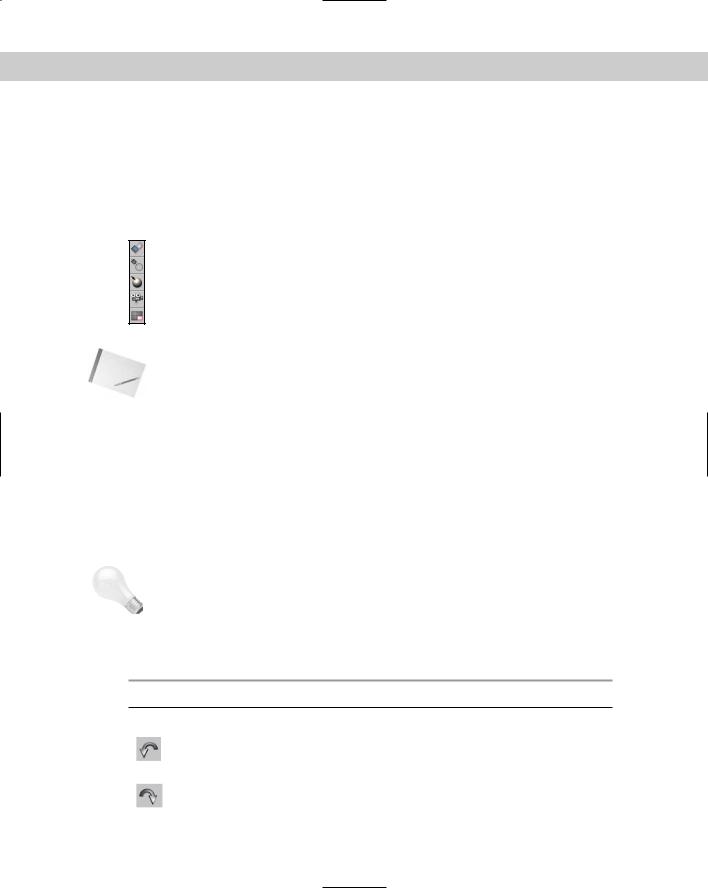
38 |
Part I Learning the Max Interface |
cursor over an icon button, the tooltip label appears. This feature is useful for identifying buttons. If you can’t remember what a specific button does, hold the cursor over the top of it and the tooltip gives you its name.
All toolbar buttons with a small triangle in the lower-right corner are flyouts. A flyout is a single toolbar button that expands to reveal additional buttons. Click and hold on the flyout to reveal the additional icons, and drag to select one. Figure 1-3 shows the flyout for the Align button on the main toolbar.
Figure 1-3: Flyout menus bundle several toolbar buttons together.
Note If you’re looking for the Tab Panel, you won’t find it. The Tab Panel, although it was a good idea, never really caught on and has been removed from this version of Max. Its former keyboard shortcut, Y, hasn’t been reused, so if you often use a command that needs a shortcut, the letter Y is available.
Starting with the main toolbar
On smaller resolution screens, the main toolbar is too long to be entirely visible. To see the entire main toolbar, you need to set your monitor resolution to be at least 1280 pixel wide. To scroll the toolbar to see the end, position the cursor on the toolbar away from the buttons, such as underneath one of the drop-down lists (the cursor changes to a hand), then click and drag the toolbar in either direction. Using the hand cursor to scroll also works in the Command Panel, Material Editor, and any other place where the panel exceeds the given space.
Tip |
The easiest way to scroll the main toolbar is to drag with the middle mouse button. |
Table 1-4 lists the controls found in the main toolbar. Buttons with flyouts are separated with commas.
Table 1-4: Main Toolbar Buttons
Toolbar Button |
Name |
Description |
|
|
|
|
Undo (Ctrl+Z) |
Removes the last performed command. You |
|
|
can set the levels of Undo in the Preferences |
|
|
dialog box. |
|
Redo (Ctrl+Y) |
Brings back the last command that was |
|
|
undone. |
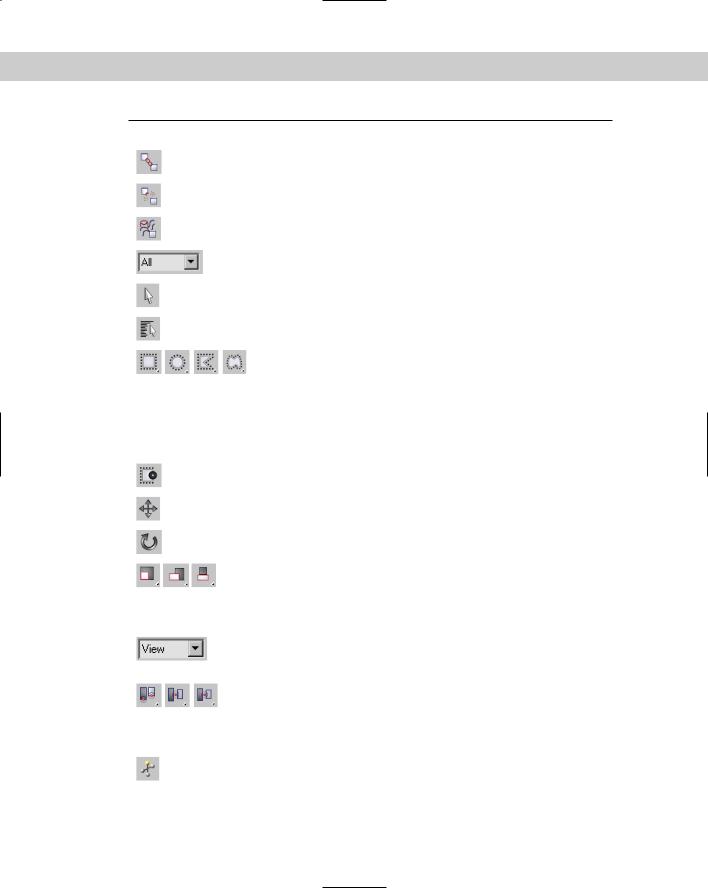
Chapter 1 Finding Your Way — Exploring the Max Interface |
39 |
Toolbar Button |
Name |
Description |
|
|
|
|
Select and Link |
Establishes links between objects. |
|
Unlink Selection |
Breaks links between objects. |
|
Bind to Space |
Assigns objects to be modified by a |
|
Warp |
space warp. |
|
Selection Filter |
Limits the type of objects that can be |
|
drop-down list |
selected. |
|
Select Object (Q) |
Chooses an object. |
|
Select by Name (H) |
Opens a dialog box for selecting objects |
|
|
by name. |
|
Rectangular |
Determines the shape used for selecting |
|
Selection Region, |
objects. |
|
Circular Selection |
|
|
Region, Fence |
|
|
Selection Region, |
|
|
Lasso Selection |
|
|
Region (Ctrl+F |
|
|
to cycle) |
|
|
Window/ |
Specifies whether an object must be crossed |
|
Crossing Toggle |
or windowed to be selected. |
|
Select and |
Selects an object and allows positional |
|
Move (W) |
translations. |
|
Select and |
Selects an object and allows rotational |
|
Rotate (E) |
transforms. |
|
Select and Uniform |
Selects an object and allows scaling |
|
Scale, Select and |
transforms using different methods. |
|
Non-Uniform Scale, |
|
|
Select and Squash |
|
|
(R to cycle) |
|
|
Reference |
Specifies the coordinate system used for |
|
Coordinate System |
transforms. |
|
drop-down list |
|
|
Use Pivot Point |
Specifies the center about which rotations |
|
Center, Use |
are completed. |
|
Selection Center, |
|
|
Use Transform |
|
|
Coordinate Center |
|
|
Select and |
Selects an object and allows parameter |
|
Manipulate |
manipulation via a manipulator. |
Continued
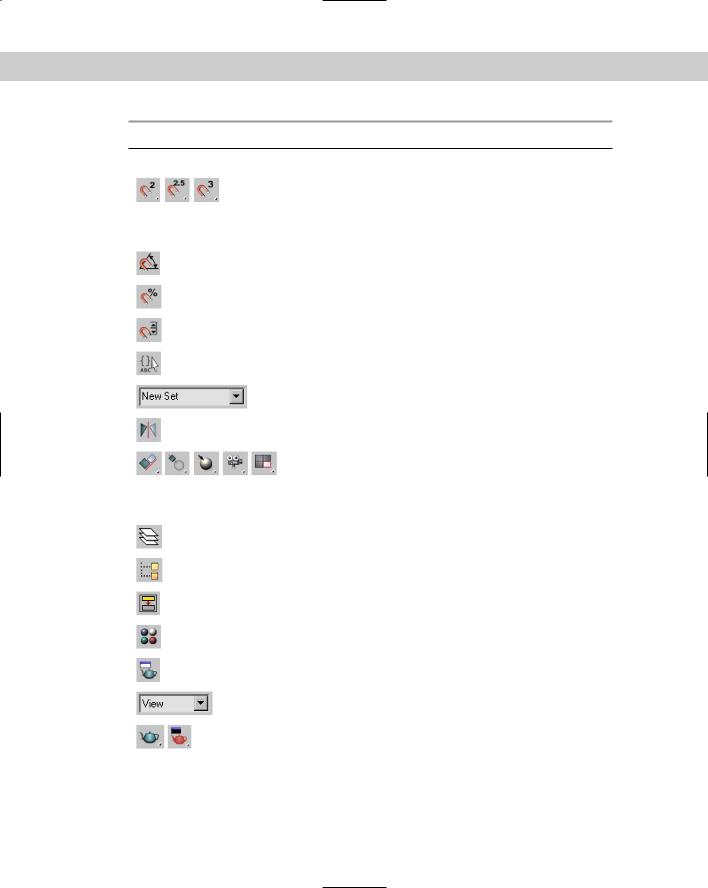
40 |
Part I Learning the Max Interface |
Table 1-4 (continued)
Toolbar Button |
Name |
Description |
|
|
|
|
Snap Toggle 2D, |
Specifies the snap mode. 2D snaps only to |
|
Snap Toggle 2.5D, |
the active construction grid, 2.5D snaps to |
|
Snap Toggle 3D (S) |
the construction grid or to geometry |
|
|
projected from the grid, and 3D snaps to |
|
|
anywhere in 3D space. |
|
Angle Snap |
Causes rotations to snap to specified angles. |
|
Toggle (A) |
|
|
Percent Snap |
Causes scaling to snap to specified |
|
(Shift+Ctrl+P) |
percentages. |
|
Spinner Snap Toggle |
Determines the amount a spinner value |
|
|
changes with each click. |
|
Named Selection Sets |
Opens a dialog box for creating and |
|
|
managing selection sets. |
|
Named Selection |
Lists and allows you to select a set of named |
|
Sets drop-down list |
objects. |
|
Mirror Selected |
Creates a mirrored copy of the selected |
|
Objects |
object. |
|
Align (Alt+A), |
Opens the alignment dialog box for |
|
Normal Align (Alt+N), |
positioning objects, allows objects to be |
|
Place Highlight |
aligned by their normals, determines the |
|
(Ctrl+H), Align to |
location of highlights, or aligns object to a |
|
Camera, Align to View |
camera or view. |
|
Layer Manager |
Opens the Layer Manager interface where |
|
|
you can work with layers. |
|
Open Curve Editor |
Opens the Function Curves Editor. |
|
Open Schematic View |
Opens the Schematic View window. |
|
Material Editor (M) |
Opens the Material Editor window. |
|
Render Scene (F10) |
Opens the Render Scene dialog box for |
|
|
setting rendering options. |
|
Render Type |
Selects the area or objects to render. |
|
drop-down list |
|
|
Quick Render |
Produces a quick test rendering of the current |
|
(Production), Quick |
viewport without opening the Render Scene |
|
Render (ActiveShade) |
dialog box. |
|
|
|
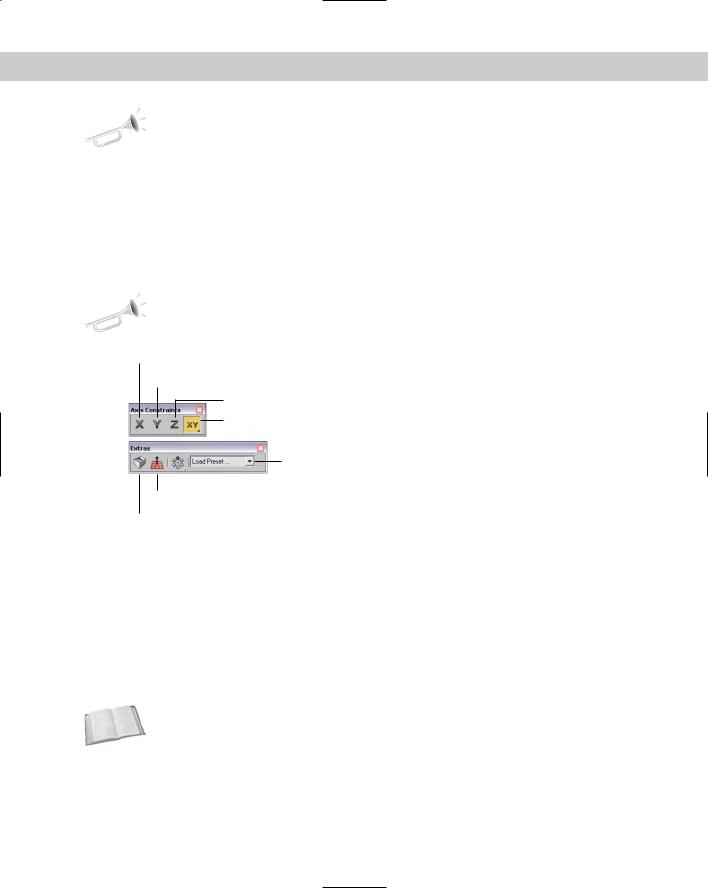
Chapter 1 Finding Your Way — Exploring the Max Interface |
41 |
New |
The only change in the main toolbar was to move the Keyboard Shortcut Override Toggle |
Feature |
button to the Extras floating toolbar and to add the Layer Manager button. The Selection |
|
|
|
Filter drop-down list and the Select and Manipulate buttons changed position and the Quick |
|
Render (Draft) button was dropped. Everything else is unchanged. Thanks, Discreet. |
Viewing the default floating toolbars
If you select the Customize Show UI Show Floating Toolbars menu command, three more toolbars appear. These are floating toolbars. You can also make them appear by selecting them from the toolbar right-click pop-up menu. The floating toolbars are Axis Constraints, Layers, and Extras and Reactor, but the Reactor toolbar is docked to the left side of the interface by default. Figure 1-4 shows the Axis Constraints and Extras toolbars.
New |
The Extras and reactor toolbars are new to 3ds max 6. |
Feature |
|
Restrict to X
Restrict to Y
Restrict to Z
Restrict to XY, YZ, XZ Plane
Render Presets drop-down list
 Array, Snapshot, Spacing Tool
Array, Snapshot, Spacing Tool
AutoGrid
Keyboard Shortcut Override Toggle
Figure 1-4: The Axis Constraints and Extras toolbars are available as floating toolbars.
The Axis Constraints toolbar includes buttons for restricting transformations to the X (F5), Y (F6), or Z (F7) axes or to restrict transformations to a single plane: XY, YZ, or ZX (F8 to cycle). The Extras toolbar includes the Keyboard Shortcut Override Toggle, AutoGrid, and a flyout button for the Array, Snapshot, and Spacing Tool (Shift+I) dialog boxes. It also includes the Rendering Presets drop-down list.
The Layers toolbar includes several buttons for creating, enabling, locking, and selecting layers. You can also set the properties for each layer. The reactor toolbar includes buttons for accessing all the reactor functions.
Cross- |
Layers are discussed in Chapter 6, “Selecting Objects and Setting Object Properties,” and |
Reference |
reactor is covered in Chapter 40, “Animating with reactor.” |
|
